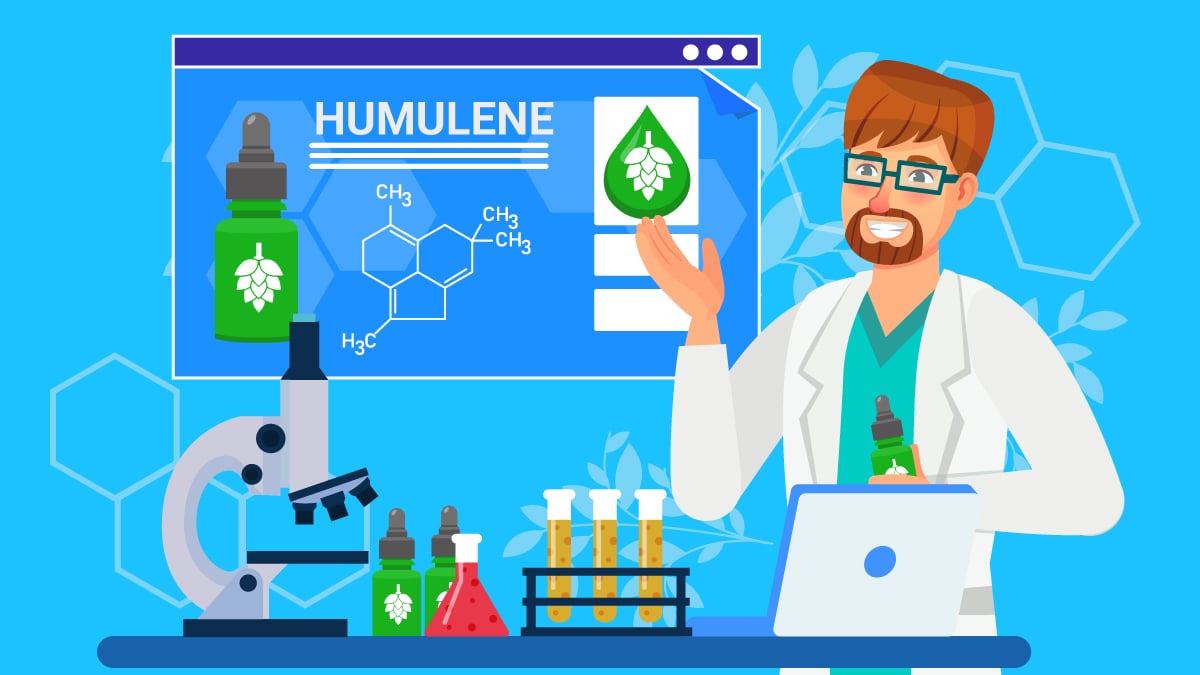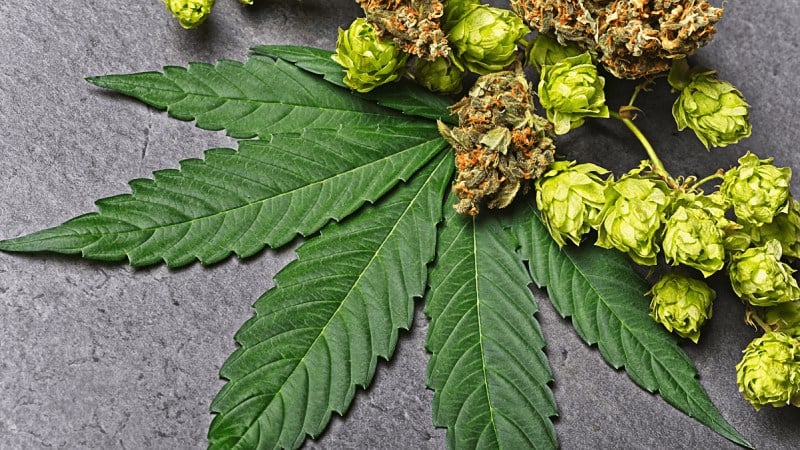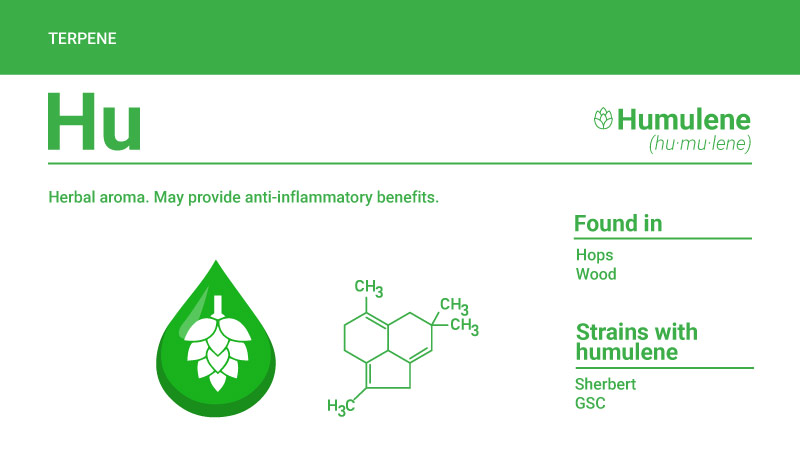Humulene Terpene: Effects, Benefits, and Strains with High Humulene

If you’ve ever come across a cannabis strain that has smelled like hops and freshly cut herbs — it probably contained high levels of humulene.
There are around 20,000 terpenes in different plants and insects, of which over 150 can be found in cannabis.
However, only a few of these terpenes occur in concentrations significant enough to contribute to the aromas and effects of cannabis.
Once believed to be responsible only for the aroma of plants — to defend plants against predators — terpenes are now known to offer serious therapeutic value. In cannabis, they work synergistically with cannabinoids to create a phenomenon known as the entourage effect.
Each terpene has its unique aroma profile and health benefits. This article sheds light on humulene, the anti-inflammatory and appetite-stimulating terpene that also occurs in beer and basil.
What is Humulene?
Humulene — formerly known as alpha-humulene or alpha-caryophyllene — was first identified in the essential oils of Humulus lupulus, commonly called hops.
Hops is a species of plant in the Cannabaceae family, which also features both hemp and marijuana plants. Humulene gives it a distinctive bitter “hoppy” taste. Depending on the other terpenes present in a strain, humulene can provide a beer-like scent to cannabis as well.
Learn more: What are Terpenes?
What Does Humulene Smell Like?
As mentioned, humulene delivers hoppy scents that resemble the aromas that you can find in freshly cut hops or craft beer. As an isomer of beta-caryophyllene, the two often appear together as a mixture in cannabis.
Humulene also delivers subtle secondary notes redolent of wood, spices, and herbs. When it comes to cannabis, it’s mostly found in sativa strains.
Plants That Contain Humulene
Cannabis and hops are the two plants where humulene appears in high concentrations. As mentioned earlier in the article, hops and cannabis are closely related because both belong to Cannabaceae.
Other sources of humulene include:
- Basil
- Ginger
- Cloves
- Black pepper
- Ginseng
- Vietnamese coriander
You can boost your natural humulene intake by adding more of these foods to your diet.
What Are the Effects of Humulene?
Humulene is a versatile terpene, but its most notable health benefits include antibacterial, anti-inflammatory, and antitumor effects. Unlike most strains, cannabis that contains a high level of humulene is also anorectic, so that it won’t produce such a pronounced appetite boost.
This compound has a long record of use in Chinese medicine for centuries due to its wide applications.
Health areas that could benefit from using humulene include:
- Metabolism
- Physical discomfort
- Bacterial infections
Interestingly, humulene’s anti-inflammatory properties are so potent that they have been compared to the potential of the steroid dexamethasone, which is one of the WHO’s recommended medicines.
You can take humulene topically, orally, or even by aerosol in forms other than the flower. It’s a common ingredient in balms and salves to the aforementioned anti-inflammatory effects. It also works with beta-caryophyllene, the only terpene that interacts with cannabinoid receptors, reinforcing its appetite-suppressing properties.
That’s just one of the many examples of the said entourage effect. When paired with other cannabinoids and terpenes, CBD and THC offer greater therapeutic potential.
How Common is Humulene in Cannabis?
Humulene is one of the most common terpenes in cannabis. However, some strains are particularly high in this compound.
The list of cannabis strains with high levels of humulene includes:
- Candyland
- Death Star
- Girl Scout Cookies (GSC)
- Headband
- Original Glue
- Pink Kush
- Super Sour Diesel
- White Widow
Need terpenes to add to your favorite cannabis products? Check out our store.
Humulene Research
Research has outlined several potential health benefits of humulene. However, due to the federal status of cannabis, most studies on this subject have been conducted on extracts from other plants. However, as the legalization movement continues to grow worldwide, the legality of cannabis may change, and scientists may explore more benefits in terms of humulene’s interaction with THC, CBD, and other cannabinoids.
A 2007 study published in the European Journal of Pharmacology found that humulene reduced inflammation in rodent models. The same study compared the potency of humulene’s anti-inflammatory effects to the ones provided by the potent corticosteroid dexamethasone [1].
In 2008, a study from Planta Medica supported these findings. It found that humulene produces anti-inflammatory effects following both oral and topical application [2].
These properties were once again highlighted in a 2009 study for the British Journal of Pharmacology that examined oral and inhaled humulene effects in mice with allergic airway inflammation [3].
It seems that humulene is an antioxidant too. A 2016 study posted in the Biomedical and Pharmacology Journal analyzed the effects of humulene on diabetic rats. The results showed that humulene decreased a marker of oxidative stress and demonstrated anti-diabetic properties [4].
There’s also a study from 2006 that underscores the antibacterial properties of humulene. The terpene was tested against Staphylococcus aureus bacteria and proved to be effective in fighting its growth. The authors of the study used a combination of humulene, alpha-pinene, and beta-caryophyllene [5].
Further research is needed to confirm the positive effects of humulene in clinical trials on humans — let’s keep our fingers crossed for more evidence emerging soon.
Chemical Structure of Humulene
Humulene is classified as a monocyclic sesquiterpene — which makes it structurally similar to other common terpenes such as beta-caryophyllene, bisabolol, guaiol, nerolidol, valencene, and more.
Humulene Specs:
- IUPAC Name: (1E,4E,8E)-2,6,6,9-tetramethylcycloundeca-1,4,8-triene
- Molecular Formula: C15H24
- Molecular Weight: 204.35
Does Humulene Get You High?
No, humulene — won’t get you high. Unlike cannabinoids, humulene doesn’t interact with the endocannabinoid receptors.
Some terpenes can influence your mood and emotion — providing a mild euphoric experience, but it’s nowhere near the signature cannabis high.
Terpenes can also affect the direction of specific cannabis strains. Strains high in humulene tend to have a relaxing effect with a chance of couch-locking the user on top of boosting creativity, relieving pain, and calming the mind.
Furthermore, terpenes such as beta-caryophyllene and myrcene are known to amplify the effects of cannabinoids. For example, the former interacts with endocannabinoid receptors to boost the therapeutic effects of THC and CBD. At the same time, the latter makes the blood-brain barrier more penetrable for THC, resulting in a more potent psychoactive experience.
There are just a few exceptions to this rule. The terpenes myristicin and salvinorin A are potent psychoactive substances — but both have a high risk of side effects (some of which can be lethal).
Related: Do Terpenes Get You High?
Summary: What Makes Humulene Special
Humulene is a major cannabis terpene. Its potential health benefits are far-reaching due to remarkable antioxidant, anti-inflammatory, and antibacterial effects.
Although no study has yet examined the benefits of humulene-rich cannabis strains, results from studies on other herbal extracts are promising, to say the least.
As the legal status of cannabis is changing across the world, we may soon expect more studies investigating humulene’s contribution to the entourage effect — and how it can be used for addressing certain symptoms and ailments in medical cannabis patients.
If you’re considering adding delta 8 THC into your daily routine for pain, stress, and cognitive boost, we recommend opting for products that include humulene in their terpene blends.
Reference:
- Fernandes, E. S., Passos, G. F., Medeiros, R., da Cunha, F. M., Ferreira, J., Campos, M. M., Pianowski, L. F., & Calixto, J. B. (2007). Anti-inflammatory effects of compounds alpha-humulene and (-)-trans-caryophyllene isolated from the essential oil of Cordia verbenacea. European journal of pharmacology, 569(3), 228–236. https://doi.org/10.1016/j.ejphar.2007.04.059
- Chaves, J. S., Leal, P. C., Pianowisky, L., & Calixto, J. B. (2008). Pharmacokinetics and tissue distribution of the sesquiterpene alpha-humulene in mice. Planta medica, 74(14), 1678–1683. https://doi.org/10.1055/s-0028-1088307
- Rogerio, A. P., Andrade, E. L., Leite, D. F., Figueiredo, C. P., & Calixto, J. B. (2009). Preventive and therapeutic anti-inflammatory properties of the sesquiterpene alpha-humulene in experimental airways allergic inflammation. British journal of pharmacology, 158(4), 1074–1087. https://doi.org/10.1111/j.1476-5381.2009.00177.x
- Gunawan I. W. G, Putra A. A. B, Widihati I. A. G. The Response to Oxidative Stress α-Humulene Compounds Hibiscus Manihot L Leaf on The Activity of 8-Hydroxy-2-Deoksiquanosin Levels Pancreatic β-Cells in Diabetic Rats. Biomed Pharmacol J 2016;9(2).
- Pichette, A., Larouche, P. L., Lebrun, M., & Legault, J. (2006). Composition and antibacterial activity of Abies balsamea essential oil. Phytotherapy research : PTR, 20(5), 371–373. https://doi.org/10.1002/ptr.1863



